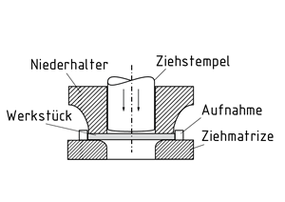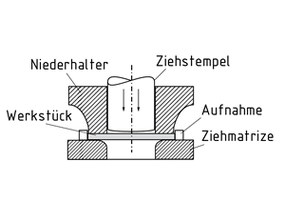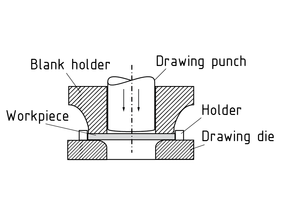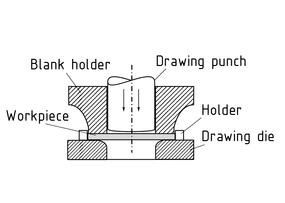
Choose one
or multiple languages
0,1,1
- German
- English
- Chinese
- Spanish
Deep-drawing

Deep-drawing reshapes metal-sheet blanks (circular blanks) into hollow bodies open on one side without intentionally modifying the sheet thickness.
The circular blank is placed centrally on the drawing die and pressed down by the blank holder with at least enough Force to prevent the formation of wrinkles. As the drawing punch forces the circular blank through the opening of the drawing die, the outer diameter of the circular blank decreases until the hollow body is fully formed. Forming takes place in the area below the blank holder as far as the tapered edge of the drawing die.
Drawbeads, a varied distribution of force on the surface and the addition of Lubricant can be used to influence the flow of Material under the blank holder. The drawing force and maximum drawing ratio can be increased by introducing a higher Friction coefficient between the circular blank and drawing punch.
Deep-drawing is a tension-pressure forming process, whereby the first draw can be followed by several more draws.
Tiefziehen

Beim Tiefziehen entstehen aus ebenen Blechzuschnitten (Ronden) einseitig offene Hohlkörper ohne gewollte Änderung der Blechdicke (Ziehstücke).
Die Ronde wird zentrisch auf die Ziehmatrize gelegt und vom Niederhalter mindestens so stark aufgedrückt, dass Faltenbildung vermieden wird. Während der Ziehstempel die Ronde durch die Öffnung der Ziehmatrize zieht, wird der äußere Durchmesser der Ronde kleiner, bis der Hohlkörper vollständig geformt ist. Umgeformt wird der Bereich unter dem Niederhalter bis zur auslaufenden Ziehringrand.
Um den Materialfluss unter dem Niederhalter zu beeinflussen, können Ziehsicken, Platinenformen, eine unterschiedliche Kraftverteilung auf der Fläche und die Schmierstoffzufuhr eingesetzt werden. Über eine höhere Reibungszahl zwischen Ronde und Ziehstempel können Ziehkraft und Grenzziehverhältnis erhöht werden.
Tiefziehen ist eine Zugdruck-Umformung, dem Erstzug können mehrere Weiterzüge folgen.
深拉

深拉将金属板坯(圆坯)重新定型为一侧开口的中空体且不改变板坯厚度。
圆坯放置在拉模中心并由坯夹施压,施加足够的力以防止起皱。拉延冲头作用于圆坯使其通过拉模的开口,圆坯的外径减小,直到完全形成中空体。在坯夹下方的区域直到拉模的锥形边缘中进行成型。
通过拉珠、力在表面上的变化分布和添加润滑剂,可以影响坯料在坯夹下的流动情况。可以通过提高圆坯和拉延冲头之间的摩擦系数来增大牵引力和最大拉伸比。
深拉是一种工艺,因此初次拉伸后可再进行后几次拉伸。
深拉
Embutido profundo

El embutido profundo cambia la forma de las láminas (chapa redonda) de los cuerpos huecos abiertos de un lado, sin modificar intencionalmente el espesor de la lámina.
La chapa circular se coloca centrada en el troquel de embutido y es presionada hacia abajo por el soporte de chapa con al menos suficiente fuerza para prevenir la formación de arrugas. A medida que el punzón de embutido uerza a la chapa circular a través de la abertura del troquel de embutido, el diámetro exterior de la chapa circular disminuye hasta que el cuerpo hueco queda conformado completamente. El conformado se lleva a cabo en el área debajo del soporte de chapa hasta el borde cónico del troquel de embutido.
Pueden usarse gotas de embutido, una distribución variada de fuerzas en la superficie, y la adición de lubricante, para influenciar el flujo de material bajo el soporte de chapa. La fuerza de embutido y la relación de embutido máximo pueden incrementarse al introducir un coeficiente de fricción más alto entre la chapa circular y el punzón de embutido.
El embutido profundo es un proceso de , donde el primer embutido puede ser seguido por varios embutidos más.
Embutido profundo
